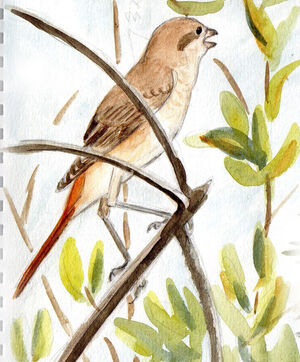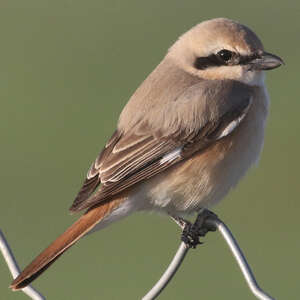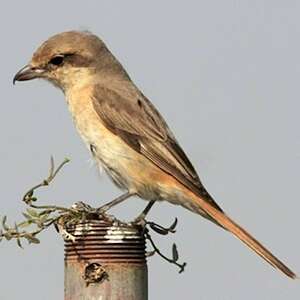Isabelline Shrike
Lanius isabellinus - Pie-grièche isabelle
Identification
The Isabelline Shrike (Lanius isabellinus) is part of a closely-related group of species, including the Great Grey Shrike (L. Collurio), the Chinese Grey Shrike (L. Arenarius) and the Turkestan Shrike, or Red-tailed Grey Shrike (L. Phoenicuroides). Up until recently, Isabellinus, Phoenicuroides and Arenarius were grouped under a single specific taxon, L. Isabellinus, with each being considered a subspecies of Isabellinus. Now, the systematics have divided them up. But distinguishing between these species is not always easy, especially from photos, as they are so similar, except for adult males, which are generally quite distinct.
This information relates to the Isabelline Shrike strictu sensu, L. Isabellinus. Its size and aspect are similar to the Great Grey Shrike.
The adult male has a pale sandy beige colour to the upper parts, from the head to the tail, usually with a slightly warmer hue on the head and rump. The lower back, uppertail coverts and tail are reddish brown, like a Redstart. The wings are dark brown, with pale beige edgings to the flight feathers and coverts, more or less visible depending on the state of the plumage. The white base to the primaries forms a white patch in the middle of the wing, behind the primary coverts. A black band including the dark and sharply contrasting eye is visible across the side of the head. It is outlined with a rather faint or indistinct pale eyebrow. The beak is black. The undersides are creamy-russet, with the flanks clearly washed with red. The legs are dark brown.
The female adult looks similar to the male, but the colours are less sharply defined and there is less contrast in the plumage. For example, the eye band is brown rather than black, and is less well-defined. The base of the beak is pinkish. The white patch to the primaries is less conspicuous, and sometimes imperceptible.The legs are a lighter brown. Finally, one can perceive some discreet dark edgings on the covert feathers of the chest and flanks breaking the uniformity of the ventral plumage.
The juvenile is easily distinguished from the adults by its scaly or vermiculated appearance of its plumage, top and bottom, the plumage itself being warmer than that of the adult. The pattern of the wing coverts with a bicolour edging, brown and cream, is particularly remarkable. The tail is russet, terminated in a brown-black. The bill is widely pink at its base. The immature first winter has reminders of this plumage. The immatures of the three taxa, isabellinus, phoenicuroides and arenarius, are very similar and difficult to distinguish from one another.
Subspecific information 3 subspecies
- Lanius isabellinus isabellinus (n China, Mongolia and s Russia)
- Lanius isabellinus arenarius (nw China)
- Lanius isabellinus tsaidamensis (wc China)
Foreign names
- Pie-grièche isabelle,
- Alcaudón isabel,
- picanço-isabel,
- Isabellwürger,
- pusztai gébics,
- Daurische Klauwier,
- Averla isabellina,
- isabellatörnskata,
- Isabellavarsler,
- strakoš hrdzavochvostý,
- ťuhýk mongolský,
- Isabellatornskade,
- punapyrstölepinkäinen,
- capsigrany pàŀlid,
- Bleiksvarri,
- dzierzba pustynna,
- Daurijas čakste,
- bledi srakoper,
- Буланый жулан,
- モウコアカモズ,
- 荒漠伯劳,
- isabellatörnskata,
- 棕尾伯勞,
Voice song and call
Its song is quite similar to that of the Lesser Grey Shrike. It is an incoherent and soft warbling, which includes both scratchy notes and melodious syllables, as well as imitations of other species. It is not unlike a common grasshopper or a Melodious Warbler. Many other birds are imitated, including the Greater Whitethroat (Acrocephalus aedon) with its fluty song. The Isabelline Shrike often sings in its winter quarters. The territorial call of the male on his territory at the beginning of the reproductive season sounds like that of the Lesser Grey Shrike. It is a loud tjien of high pitch. There is also an alarm tche tche tche tche....
Habitat
Behaviour character trait
The Isabelline Shrike is most often seen alone outside of the breeding season. It perches at the top of bushes and tends to flick its tail more than a Great Grey Shrike. After catching its prey, the Isabelline Shrike returns to its perch to consume it or store it for later. It uses the same technique as the majority of other species of shrikes by impaling its surplus victims on a thorn, a barbed wire or any other sharp element capable of supporting them and acting as a larder.
Flight
Dietfeeding habits
The Isabelline Shrike's diet is mostly insectivorous. It mainly digsests beetles, orthopterans (grasshoppers, crickets) and lepidopterans (butterflies). The species also eats spiders and snails occasionally. It hunts from a perch that allows it to have a nice view. From there, it glides in flight to its prey which is generally seized with the beak on the ground. It also pursues flying insects in the air and more rarely, small passerines.
Reproduction nesting
The breeding begins late, resulting in only one brood being raised each year. As with isabelline shrikes, males usually arrive on the breeding territories a few days before the females.
However, some observations suggest that some pairs have already formed during the halts along their journey. In the Altai region, the first eggs of ssp speculigerus are only found at the end of May.The birds reproduce in their second civil year. The nuptial parade sees the male dancing before the female, chest inflated and displaying its black mask, white spots on its wings and bright reddish tail lifted and spread out. The breeding site is chosen by him. The nest is similar to that of the shrike. It is built in a bush or shrub about one or two meters high on average. It is a fairly large bowl made of twigs, stems, leaves and moss, lined inside with dry grass and soft elements like sheep wool.
The laying is of 4 or 5 pale blue-green eggs with brown spots. The female incubates alone for 13 to 17 days. The chicks remain in the nest for 13 to 16 days and will be dependent on the parents for a month after fledging.
Geographic range
The Isabelline Shrike is the breeding taxon in Mongolia, from SE Altai to NE Transbaikal region in Russia, and south to the NE Tian Shan and Chinese Xinjiang. It is a great migrating bird that spends its boreal winter in the Arabian Peninsula and NE Africa. It is an accidental species in Europe, where it can sometimes be seen in the same habitats as the Woodchat Shrike in autumn.
Threats - protection
Sources of information
- IOC World Bird List (v15.1), Gill, F and D Donsker (Eds). 2025-12-07.
Other sources of interest
 Specification sheet created on
28/10/2023 by Alexandre Knochel with help of Daniel Le-Dantec
Specification sheet created on
28/10/2023 by Alexandre Knochel with help of Daniel Le-Dantec partially rewritten on 00/00/0000 by Jean François
Translation by AI Oiseaux.net
© 1996-2025 Oiseaux.net
- Accipitriformes
- Aegotheliformes
- Anseriformes
- Apodiformes
- Apterygiformes
- Bucerotiformes
- Caprimulgiformes
- Cariamiformes
- Casuariiformes
- Charadriiformes
- Ciconiiformes
- Coliiformes
- Columbiformes
- Coraciiformes
- Cuculiformes
- Eurypygiformes
- Falconiformes
- Galliformes
- Gaviiformes
- Gruiformes
- Leptosomiformes
- Mesitornithiformes
- Musophagiformes
- Nyctibiiformes
- Opisthocomiformes
- Otidiformes
- Passeriformes
- Pelecaniformes
- Phaethontiformes
- Phoenicopteriformes
- Piciformes
- Podargiformes
- Podicipediformes
- Procellariiformes
- Psittaciformes
- Pterocliformes
- Rheiformes
- Sphenisciformes
- Steatornithiformes
- Strigiformes
- Struthioniformes
- Suliformes
- Tinamiformes
- Trogoniformes






























